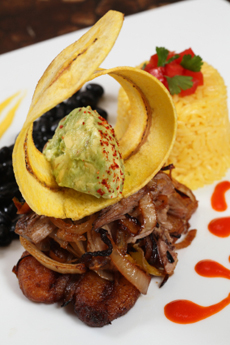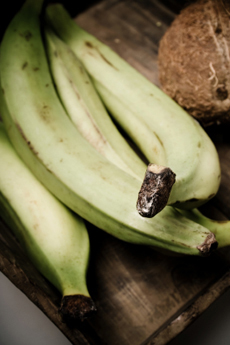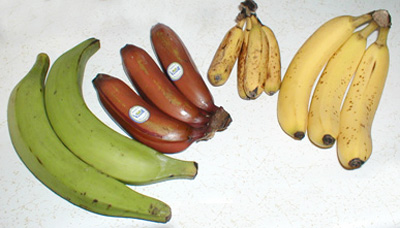
 Plantains two ways: As long, fried chips with guacamole, and fried plantains served with a sauteed pork and onions. Black beans and saffron rice complete the plate. Photo by Christian Lazzari | IST. Plantains two ways: As long, fried chips with guacamole, and fried plantains served with a sauteed pork and onions. Black beans and saffron rice complete the plate. Photo by Christian Lazzari | IST.
CHRISTINA GONZÁLEZ is an Editorial Intern at THE NIBBLE.
|
March 2010
|
 |
Plantains: Vegetable, Dessert & Snack Chip
Page 1: Plantains Overview + The Difference Between Plantains & Bananas
CAPSULE REPORT: Love chips? Looking for a change of pace from potato chips or a healthier alternative to banana chips? Plantains are a starchier, less-sweet version of their cousin, the banana, and a staple food in many parts of the world. Grab ‘Em Snacks has created a line of gourmet plantain chips in seven flavors, from salted to spicy to sweet. We tried all seven and enjoyed their starchy crunch. Several really stood out: Chili Garlicious, Jalapeño Heat and Sea Salt Goodness were our favorites. But first, learn about the plantain. This is Page 1 of a three-page review. Click on the black links below to visit other pages.
Plantain Overview
Plantains are cousins to the banana, and resemble their more familiar relatives, except they are firmer, larger and have thicker skins. Both plantains and bananas belong to the Musa benus, one of three genera in the Musaceae famiy, which includes bananas and plantains. There are more than 50 species of Musa.
A bit of botanical trivia: the stems of Musa are thick leaf stalks and not wood; these plants are all actually huge herbs. All parts of the plant are used, including the very large leaves, which can be used as a natural insulator that also imparts flavor when cooking.
Plantains are native to South Asia, but were brought to Africa and later, the Americas and the Caribbean. In fact, this starchy staple is still served regularly on millions of tables in places as far-flung as Africa (Nigeria, South Africa), the Caribbean (Cuba, Jamaica, Guyana, Puerto Rico, Venezuela), India, The Philippines and the United States.
High in potassium, fiber, vitamin A and vitamin C, and only 179 calories per cup, plantains are an affordable source of high nutritional value for many people. But their versatility is also a major reason for their appeal.
Unlike the bananas that we snack on or add to our cereal (also known as dessert bananas), plantains are generally cooked before they are eaten. They ripen more slowly than bananas and can keep for up to two weeks, growing sweeter as they ripen. They can be cooked at any stage of ripeness. |
|

Plantains and a tropical neighbor, coconut. Photo by Ladida. |
The Difference Between Plantains & Bananas
These botanical cousins look alike. So how can you tell if it’s a green banana or a plantain? The first clue: plantains are much longer and have a thicker skin. Here’s the scoop:
| Plantains |
Bananas |
| Starchy |
Sweet |
| Used As A Vegetable |
Used As A Fruit |
| Longer (See Photo Below) |
Shorter |
| Thicker Skin |
Thinner Skin |
Resemble Green Bananas, Turn
Yellow, Spotted Yellow & Then Black As They Ripen |
Green When Unripe, Yellow When Ripe, Then Spotted Yellow & Black When Overripe |
| |
|
 |
| From left to right: plantains, red bananas, Spanish bananas (small and sweet) and the typical supermarket banana, or Cavendish banana. Photo by Timothy Pilgrim | Wikimedia Commons. |
More Musa trivia: The word “banana” came into our language from Spain, via a West African language (possibly Wolof), around 1597 C.E.
Now that you can tell them apart, how about cooking with plantains?
Continue To Page 2: Cooking With Plantains
Go To The Article Index Above
READ MORE REVIEWS OF OUR FAVORITE
SNACKS |

|
|
|